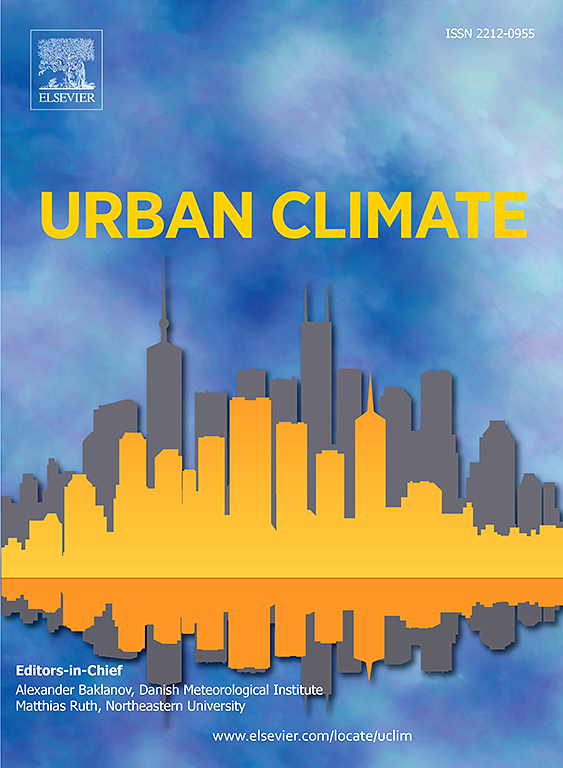树木对街道行人热舒适的局部影响
IF 6
2区 工程技术
Q1 ENVIRONMENTAL SCIENCES
引用次数: 0
摘要
城市热舒适可以通过树木来改善。更好地了解树木对城市街道气候的影响,可以为优化利用城市植被以调节温度提供更好的指导。在本研究中,我们以蒙特利尔一棵常见的行道树为模型,通过不同的种植模式、街道朝向和风向,探索并量化了行道树对城市热舒适的改善和恶化。在24小时的周期内,研究了树木对多层住宅的街道水平和阳台水平室外热舒适的影响。研究采用了一套基于OpenFOAM的城市气候模型,考虑了湍流和浮力气流、多孔介质中的热量和水分输送以及短波和长波辐射交换。结果以通用热气候指数(UTCI)表示。为了量化树木对白天和夜间热舒适影响的区域和时期,我们引入了几个新的舒适指数:冷却和加热指数,分别描述热舒适改善或恶化的水平,以及冷却和加热区域,表明街道的哪些区域受到影响。我们展示了树冠在白天是强大的资产,因为树木拦截太阳辐射并提供遮阳。然而,与之对应的是,它们可能会导致夜间热舒适的恶化,有时会持续到早晨。街道朝向比风向对热舒适的影响更大,而与街道平行的风比垂直的风带来更舒适的条件。我们确定了增强热舒适性的街道朝向和树木种植模式。本文章由计算机程序翻译,如有差异,请以英文原文为准。
Local impact of trees on thermal comfort of pedestrians in streets
Urban thermal comfort can be improved by trees. A better understanding of the effects of trees on urban climate in streets can provide better guidelines on the optimized use of vegetation in cities to moderate temperatures. In this study, we explore and quantify both improvement and deterioration of urban thermal comfort due to street trees, modeled based on a common street tree in Montreal, by varying planting patterns, street orientation and wind direction. The impact of trees on outdoor thermal comfort is studied at street level and at balcony level for multistoried residential buildings over 24-hour cycles. The study is performed with a suite of urban climate models based on OpenFOAM, considering turbulent and buoyant air flow, heat and moisture transport in porous media and short- and long-wave radiative exchanges. Results are presented in terms of Universal Thermal Climate Index (UTCI). To quantify zones and periods of impact of trees on thermal comfort during day and night, we introduce several new comfort indices: the cooling and heating indices, that describe the level of thermal comfort improvement or deterioration, respectively, and the cooling and heating areas, indicating which areas of the street are affected. We show that tree canopies can be strong assets during the day, as trees intercept solar radiation and provide shading. However, as a counterpoint, they may cause deterioration of thermal comfort during night, stretching sometimes into the morning. Street orientation is found to have a larger impact on thermal comfort than wind direction, while wind flow parallel to the street leads to more comfortable conditions than perpendicular wind. We identify street orientations and tree planting patterns that enhance thermal comfort.
求助全文
通过发布文献求助,成功后即可免费获取论文全文。
去求助
来源期刊

Urban Climate
Social Sciences-Urban Studies
CiteScore
9.70
自引率
9.40%
发文量
286
期刊介绍:
Urban Climate serves the scientific and decision making communities with the publication of research on theory, science and applications relevant to understanding urban climatic conditions and change in relation to their geography and to demographic, socioeconomic, institutional, technological and environmental dynamics and global change. Targeted towards both disciplinary and interdisciplinary audiences, this journal publishes original research papers, comprehensive review articles, book reviews, and short communications on topics including, but not limited to, the following:
Urban meteorology and climate[...]
Urban environmental pollution[...]
Adaptation to global change[...]
Urban economic and social issues[...]
Research Approaches[...]
 求助内容:
求助内容: 应助结果提醒方式:
应助结果提醒方式:


